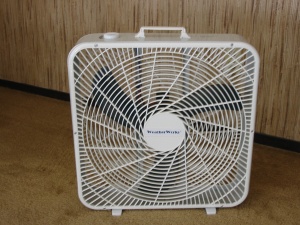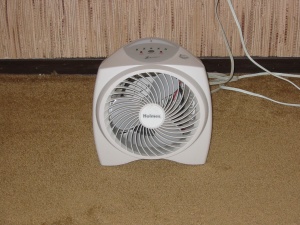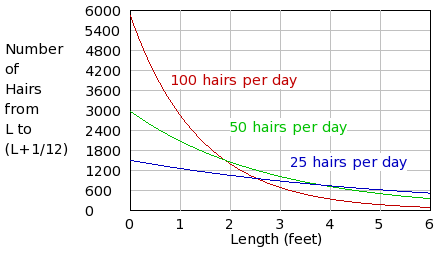Long Hair CareEd Grochowski Last updated 8-30-2008
IntroductionThis article explains how to care for long hair. Long hair requires more careful maintenance than short hair. People who are growing long hair for the first time usually need to learn proper hair care techniques. Visible hair is dead tissue; only the roots are alive. Because hair is dead, the body does not repair hair in the same manner that it repairs living organs such as the skin. Hair grows at an average rate of 6 inches per year, requiring 6 years to reach a length of 3 feet. Thus, having long hair means keeping one's hair in good condition for 3 to 10 years. Properly maintained hair will outlast most clothing - shirts, pants, and shoes will all wear out in less time than hair! It is important to note that there are different types of hair. A hair care routine that works well for one person may not work for the next person. You will need to experiment with your hair care routine to determine what works best for you. I wrote this article based on my experiences in caring for my hair. WashingHow often to wash depends on one's hair type. My hair is oily, and so I wash it every 1-3 days using various brands of mild shampoo. I prefer shampoos that have sodium laureth sulfate or sodium lauryl sulfate as the main ingredient. I avoid shampoos that are based on ammonium. There does not appear to be any relationship between quality and price: inexpensive shampoos work just as well as expensive ones. I choose shampoos based on their ingredients. Since shampooing removes the hair's natural oil (sebum), conditioners provide a substitute, usually silicone. I do not like the feeling of silicone in my hair, and so I do not use conditioners. My hair's natural oil will return in a day. A valuable technique for very long hair is to wash only the scalp during most washes (since the oil originates there), and to wash the length of the hair only occasionally. I perform a scalp wash by folding up the length of my hair, holding my hair over my head in the shower with one arm, and using the other arm to apply shampoo. A shampoo bottle with a pump makes this easy. Rinse as usual. The length of the hair remains dry. DryingDrying is the most time-consuming part of having long hair. It is not possible to both quickly and safely dry long hair. My hair requires at least an hour to dry, depending on the temperature. During this time, caution must be exercised because hair is heavy when wet. I use a towel to gently blot the hair, and then air-dry it. In the summer, drying may be sped up with the aid of a box fan on the left. Moving air will evaporate water much faster than air that is standing still. In the winter, the air is too cold to evaporate water so I use the electric fan heater on the right to heat up the room (do not use a radiant heater). The fan heater is relatively safe because the air coming out is only warm. I sit at least 5 feet away from either the box fan or the heater. Fortunately, I can do other things while my hair dries.  
Hair dryers for long hair
Blow dryers are to be avoided because they get hot enough to damage the hair. Unlike the skin, hair will not detect temperatures that are potentially high enough to cause burns. If you must use a blow dryer, keep the nozzle a safe distance from the hair by holding the blow dryer at arm's length, or by placing it on a stand several feet away. I consider blow dryers to be broken by design - they are not intended for hair that has to last for years! UntanglingTangles are usually caused by lint. A small piece of lint will wrap itself around a few hairs which become stuck together after washing. The lint is invisible unless viewed closely in bright light. The best time to untangle hair is shortly after washing and drying it. The hair should be dry or nearly dry. Hair should not be untangled when wet due to breakage. I untangle my hair using my fingers and a wide-toothed wooden comb. I start by finger combing to remove large tangles. Finger combing is the gentlest but slowest method of untangling hair. It has the advantage that one can easily sense the amount of tension and stop before breakage occurs. I finish untangling using the comb. I start combing at the ends and work my way up towards the scalp. The wide-toothed wooden comb does not have sharp edges and is quite gentle. I do not recommend the use of plastic combs because they have a seam where the two halves of the mold come together. RestrainingSurprisingly, my long hair does not require restraint. Due to its length and straightness, gravity keeps my hair over my shoulders, not in my face, essentially all the time. That is how hair is supposed to be! When working in the garden, I tuck my hair into my shirt to keep it out of the way. When performing work that must not have any hair in the way (such as when using power tools or painting), I wear a shower cap. I do not recommend the use of elastic bands as they tend to leave a crimp in the hair. If tying up one's hair is essential, use a wide band that does not exert too much pressure. TrimmingEveryone has a different terminal length - the maximal length that hair will grow. If one's terminal length is greater than one's desired length, periodic trims are necessary. I recommend Feye's self-trim method to avoid trusting one's hair to a barber or hairdresser who may fail to understand that only a small trim is desired. When doing a self-trim, take off only one inch at a time. An untangling and touch-up cycle may be required to even up any stray strands. The ends are the only place that hair should be trimmed. Alternatively, one can forgo trims altogether and the hair will develop natural tapered ends. SheddingPeople who are growing long hair for the first time invariably notice an increase in shedding. This is not because they are shedding more hairs, but rather the shed hairs are becoming more noticeable due to greater length. It is normal to shed tens of hairs to a hundred hairs per day. Every person's shed rate is different. Shedding is caused by the hair's growth cycle and random breakage. The length of one's hair does not affect the rate of shedding. Because of shedding, one's hair contains a mix of all different lengths: more strands near the scalp and fewer towards the ends. This is illustrated in the following graph. 
The graph is generated from a mathematical model that starts with 100,000 hairs and a growth rate of 0.5 inches per month. The model makes the assumption that all hairs have an equal probability of shedding, regardless of length. While only approximately true, it results in an exponential decay of the number of hairs greater than a given length. With a shed rate of 100 hairs per day, only 11% will make it past 3 feet. With a shed rate of 25 hairs per day, one third will reach 6 feet. Clearly, a low shed rate is essential to having long hair. Surprisingly, more short hairs are shed than long hairs. This is due to the number of short hairs being greater as shown in the following graph. 
Shed hairs end up on the floors and carpets. Vacuuming the carpets is problematic. Most vacuum cleaners are not designed to handle long hair - long hair wraps around the beater brush, eventually jamming it. My advice is to shop for a vacuum cleaner that can easily be disassembled and long hairs removed. The frequency with which the vacuum cleaner needs to be disassembled can be reduced by raking as much hair as possible from the carpets prior to vacuuming. SleepingSleeping with long hair is not problematic. I sleep with my hair draped over the edge of the bed so that the ends rest on the floor. Gravity keeps it there all night. It is really quite unobtrusive! HazardsHair is quite strong; however, it can be damaged by high temperatures, chemicals, abrasion, or excessive force. A longhaired person must avoid such hazards. A surprising number of products are potentially hazardous to long hair. Some products are obviously hazardous due to heat or moving parts. Others are more subtly hazardous. Here are a few to avoid.
Cars have a lot of places that can accidentally catch long hair. Use caution when getting in or out of a car, closing the door, and putting on the seat belt. Prior to getting into a car, I drape my hair over my right shoulder. I carefully put on my seat belt (under my hair) and drive with my hair in my lap. That keeps it out of trouble. Finally, one should avoid sitting on classic length and longer hair. DietIt is said that one's hair is a reflection of one's health. I believe this is true. Any balanced diet will enable one to grow long hair. There are no foods that are particularly good or bad for hair growth. I am a vegetarian for ethical reasons, and can personally dispel the myth that vegetarians do not get enough protein (hair is protein strands)! FashionOne good thing about having really long hair is that it never goes in or out of style. Fashion is all about change, and hair changes slowly. Really long hair transcends fashion, trendiness, and seasons. Instead, it is timeless. That is much better! ConclusionWhile some effort is required to keep long hair in good condition for many years, with proper care, hair is quite durable and will outlast most clothing. |